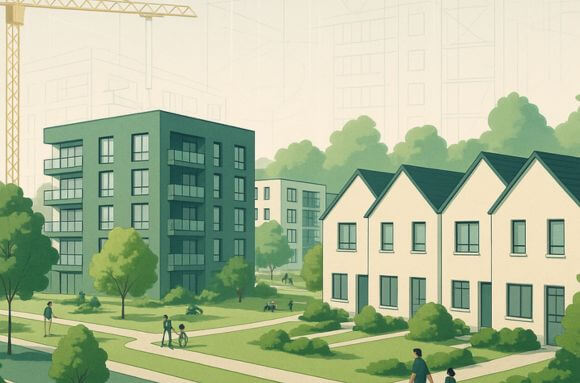Ireland’s planning system is undergoing its most extensive changes since 2000. Whether you are buying a home, funding a scheme, or assessing market risk, a clear grasp of the latest rules will help you make informed decisions. This guide outlines today’s planning pathways, highlights the 2025 reforms, and shows how Castlethorn navigates the process to deliver compliant, community‑focused developments.
Why Planning Reform Matters
Delays at appeals stage can add several months to a project, affecting thousands of consented units nationwide. The forthcoming Planning & Development (Amendment) Bill 2025—currently before the Oireachtas—aims to streamline decision‑making through statutory timelines and a national digital application portal.
How the Irish Planning System Works
Ireland operates a plan‑led system:
- Local Planning Authorities (LPAs) prepare County or City Development Plans every five years.
- Development proposals must be consistent with these plans or justify any material contravention.
- An Coimisiún Pleanála (renamed from An Bord Pleanála in 2024) hears appeals and certain strategic cases.
- Strategic Development Zones (SDZs) provide pre‑agreed masterplans, giving developers clarity on density, land‑use mix and phasing.
The Standard Planning Pathway
Below summarises a typical housing‑scheme application and the statutory deadlines proposed under the 2025 Bill:
- Pre-application consultation (Section 247) – A mandatory design meeting with the local planning authority, now capped at four weeks (formerly 4–6 weeks).
- Application lodgement – Submit all forms, drawings and technical reports; this step has no set duration but triggers public consultation.
- Public observation period – Third parties have five weeks to lodge submissions (unchanged).
- LPA decision – The planning authority must grant or refuse permission within 10 weeks (down from the typical 8–12 week window).
- Appeal to An Coimisiún Pleanála – A full de-novo reassessment is limited to 20 weeks, replacing the 30–40 week norm.
- Judicial review (optional) – Any High Court challenge must begin within eight weeks of the appeal decision; substantive hearings can still run 9–12 months.
*Subject to enactment of the Planning & Development (Amendment) Bill 2025 and S.I. 263/2025 regulations.
The Large‑Scale Residential Development (LRD) Route
Introduced in 2021, the LRD process replaces the former SHD scheme while restoring first‑instance decisions to LPAs, for example:
- Schemes of 100 or more housing units — for example, a multi-phase suburban neighbourhood — may have up to 30% of the gross floor area dedicated to non-residential.
- Student accommodation with 200 or more bed spaces — like a purpose-built student complex — where mixed student/housing projects qualify if either threshold is met.
Projects must follow this project flow: mandatory pre-LRD meeting → LPA decision (initial eight-week target, extendable) → appeal if required.
Key Reforms Proposed for 2024‑25
The draft legislation introduces five major changes:
- Statutory decision deadlines of 10 weeks for LPAs and 20 weeks for appeals, aiming to improve programme certainty.
- National Digital Planning Portal for a one-stop e-planning interface that will help streamline administration and enhances transparency.
- Urban Development Zones to fast-track brownfield regeneration where infrastructure exists.
- Streamlined judicial-review process that shortens the leave-application window to eight weeks..
- Environmental-assessment alignment to consolidate SEA/EIA screening with EU law, which may lower future legal exposure for investors.
An Coimisiún Pleanála has set an internal goal of determining 80% of appeal cases within the new deadlines by the end of 2025. Collectively, these reforms are designed to enhance certainty and accelerate housing delivery across Ireland.
Typical Conditions & Compliance Checks
Developers should anticipate the following standard conditions:
- Part V social or affordable housing contribution (10% of units or equivalent).
- Density & Height requirements under the 2023 Sustainable Residential Development guidelines.
- Transport & Parking standards—schemes near high‑capacity public transport may require fewer car spaces.
- Environmental Assessments—EIAR for projects > 500 units or on sensitive sites; Appropriate Assessment (AA) where Natura 2000 sites are within the influence zone.
- Construction Management Plans covering noise, dust, traffic and site safety.
Implications & Next Steps
Due‑diligence checklist:
- Verify planning status on the local authority’s online register.
- Check appeal outcomes for conditions that affect phasing or cost.
- Confirm expiry & commencement—permissions generally lapse after five years unless substantial works begin.
- Request compliance documentation—Part V agreements, EIAR approvals, planning‑condition trackers.
- Monitor legislative updates—subscribe to Castlethorn Insights for timely alerts.
Conclusion
The 2025 planning reforms aim to deliver faster, clearer decisions that support Ireland’s target of 300,000 additional homes by 2030. By engaging early with local authorities, preparing comprehensive documentation and tracking statutory timelines, Castlethorn helps to mitigate delivery risks for investors and provide certainty for homebuyers.
Explore further: See our free Help‑to‑Buy Scheme 2025 Checklist to discover what first‑time buyers need to know.
Disclaimer: This article is provided for general information only and does not constitute legal or financial advice. Always consult a qualified professional for project‑specific guidance.




